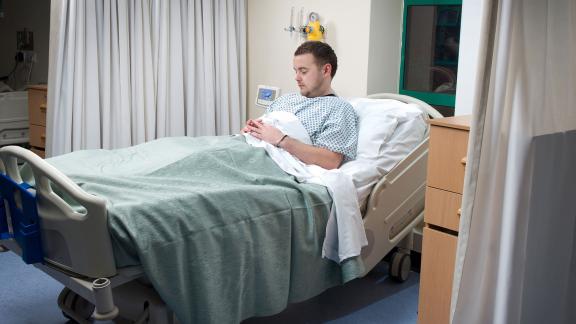What the latest data tells us about bed occupancy

At a glance
- General and acute (G&A) bed occupancy was 92.3 per cent nationally, with adult general and acute at 93.6 per cent for week ending 13 February. Adult critical care meanwhile rose slightly to 75.3 per cent.
- The latest statistics show acute bed occupancy dropping slightly for the first time following six consecutive weeks of increases, with 11 trusts reporting overall G&A bed occupancy over 97 per cent, and a further 11 reporting adult G&A occupancy over 98 per cent.
- The levels are now close to pre-pandemic, after occupancy reduced over Christmas. Members are telling us that they are struggling to clear bed space and the lack of patient flow is a key factor in their ambulance handover delays.
- Bed occupancy numbers continue to show the NHS ‘running hot’ and close to capacity, with much higher occupancy rates compared to other European countries.
What is the current bed occupancy picture?
Total general and acute bed occupancy week ending 13 February was 92.3 per cent, down from 92.6 per cent the previous week. This is the first week in seven that occupancy has declined, following the Christmas period.
Of those, 91,100 adult G&A beds were open on average and 85,300 occupied, an occupancy rate of 93.6 per cent compared to 93.8 per cent last week. Eleven trusts reported a bed occupancy in adult G&A beds of over 98 per cent, with one trust reporting 100 per cent.
Meanwhile adult critical care occupancy rose slightly to 75.3 per cent from 75 per cent last week, with 3,055 beds out of 4,054 occupied on an average day.
Trusts reported to us that prior to Christmas they had been working with local partners to achieve lower occupancy to help manage the rising COVID-19 demand, trying to reduce length of stay and ensure the availability of same-day emergency care.
How does this feel for members
Members commented that the impact of running hot on bed occupancy is one of a number of factors impacting on the flow of patients through hospitals, but that, at times, this is creating significant issues.
A trust in the Midlands this week declared a clinical incident due to the inability to clear bed space and discharge medically fit patients. A lack of patient flow and high occupancy was also cited as a reason another trust in that region was seeing increases in ambulance handover delays. Further member feedback highlighted challenges discharging to the care sector and mental health settings meant patients staying for longer than necessary on acute wards.
Some members in the south west, a region particularly affected by occupancy pressures, have been experiencing links between increasing occupancy, estates and being able to provide the most appropriate care. For instance, a member reported a correlation between increasing levels of bed occupancy and single sex breaches recently (unjustified mixing in relation to sleeping accommodation). Another member highlighted the impact of having an older estate, specifically a lack of side rooms in which to isolate COVID-19 patients, initially admitted with other conditions.
Regional split
The south-west region has the highest bed occupancy week ending 13 February of 94.7 per cent, down from 95.3 per cent last week. Bed occupancy was down slightly in all regions bar east of England, where it rose from 92 per cent to 92.5 per cent.
Comparison to other years
Although overall occupancy was down slightly last week, the data is starting to back up that assertion that occupancy is closer to pre-pandemic, having been much lower during the 2020/21 winter.
In the equivalent weeks in the three years prior, occupancy was 93.9 per cent, 95 per cent and 93.7 per cent, compared to 92.3 per cent this week.
Overall capacity available to treat inpatients has seen a post-pandemic uptick,but remains lower than previous years. In terms of available beds, the average number of acute beds (adult and paediatric) open this winter so far has been 96,331[1]. Last winter on an average day 90,557 beds were open, in 2019/20[2] it was 97,494, in 2018/19 96,939 and in 2017/18 97,351.
Comparison with other countries
The NHS is known to ‘run hot’ and the pandemic has shown the need to have spare bed capacity and flexibility in the ways they can be used if there is unexpected or sudden demand. For instance, as we saw with the emergence of the Omicron variant in December.
OECD data has long shown the United Kingdom has a relatively low number of beds per 1,000 population compared to other countries, with an estimate of 2.5 hospital beds per 1,000 in 2019, below the OECD38 average of 4.4 and behind western European neighbours such as France (5.8) and Germany (7.9).
Around half of OECD countries had bed occupancy rates between 70 and 80 per cent in total based on the latest data available, with the OECD average at 76 per cent in 2019.
How is the NHS performing this winter? 7 to 13 February
Data released on 17 February 2022 shows continued challenges with patient flow, with discharges and ambulance handovers both seeing significant delays.
Emergency care
There were 85,513 ambulance arrivals to A&Es in week ending 13 February, up slightly (471) from the previous week. Of those arrivals, there were 17,063 handover delays over 30 minutes (20 per cent) and 6,855 over 60 minutes (8 per cent). This is an improvement on last week where 21.4 per cent of all handovers were impacted by a delay over 30 minutes (18,193 of 85,042 arrivals).
However, handover delays are still historically high, and some members have told us challenges with patient flow and high bed occupancy are contributing to this ongoing problem. On the same day as the data was released, NHS England and the Care Quality Commission intervened saying that there was a strong correlation between handover delays at hospitals and long ambulance response times, and a whole-system approach was required to tackle challenges across the urgent and emergency care pathway.
The chart below shows a comparison of the volume of long delays in England compared to previous winters, which have previously dropped more significantly into the new year and from lower initial levels.
The problem varies considerably across providers, with 12 trusts having delays of more than 30 minutes in more than 40 per cent of handovers, but 37 recording delays of half an hour or more in less than 10 per cent of arrivals over the last week.
In the south west, where bed occupancy is also the highest, in week ending 13 February over 34 per cent of handovers were over 30 minutes but in London and the south east this was 16 and 12 per cent respectively.
Discharge
We focused on discharges last week and the picture continues to be challenging. On an average day this week, 12,168 patients remained in hospital despite being medically fit to discharge. That’s an improvement from the 12,387 last week, with 9,425 (43.6 per cent) of patients medically fit to discharge successfully being discharged per day, the best since December, in which each week averaged over 45 per cent.
These medically fit patients make up approximately 14 per cent of the total patients in beds in England, highlighting the continued issues with discharging to the community, other NHS services, social care and mental health settings.
Of those patients who no longer meet the criteria to reside, on an average day 6,011 had been in hospital for over 21 days, slightly up from 5,968 the previous week. The below chart shows the number of discharges of these long stay patients throughout the winter, with the uptick prior to Christmas clear. 710 were discharged on an average day last week.
Absences
62,777 staff in acute trusts were absent on an average day with 21,325 (34 per cent) off due to COVID-19 related reasons, compared to 68,380 (with 26,120 due to COVID-19) in the previous week.
This is falling, but perhaps not in line with the dramatic decrease in case numbers. The seven-day average of cases in England has dropped from 177,813 on 1 January to 47,997 now (a 73 per cent decrease) while over the same time period for COVID-19 related absences has fallen from 40,676 per day to 21,325 (a 47.6 per cent decrease). Although there are clearly complexities between the two metrics, it shows that COVID-19 continues to have an impact on workforce numbers.
The percentage of absences due to COVID-19 was highest in the south west (38.3 per cent) and south east (38.1 per cent) and lowest in the north east and Yorkshire (29.8 per cent) and north west (30 per cent).



